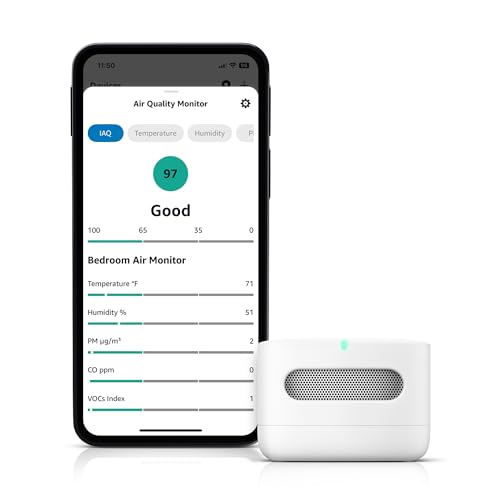For months, it felt like I was in a constant battle with my own home. My allergies were flaring up more than ever, leading to sinus issues and a general feeling of being unwell. I started to wonder about the invisible elements floating around me—dust, chemicals from cleaning supplies, or worse. Ignoring it wasn’t an option, as it was directly impacting my health. I needed a way to understand my indoor environment, which led me to the Amazon Smart Air Quality Monitor.
Before you purchase any indoor air quality monitor, it’s essential to understand the problem they solve. These devices make the invisible visible, giving you data on airborne particulates and chemicals that can affect your health, comfort, and well-being. An air quality monitor is for anyone who wants to take a proactive approach to their home environment. This includes allergy sufferers, parents with young children, pet owners, and anyone living in an area with high outdoor pollution or simply wanting a healthier living space.
However, this category of device isn’t for everyone. If you prefer a simple, set-it-and-forget-it solution with no data to interpret, you might be better off just investing in a good air purifier with an auto mode. The ideal customer for an air quality monitor is someone who is data-curious and willing to use that information to make changes, whether manually opening a window or setting up smart home automations. Before buying, consider a few key factors: what specific pollutants does it track (PM2.5, VOCs, CO)? How do you access the data (a screen, a dedicated app, a smart home ecosystem)? And most importantly, what can you do with that data once you have it?
- Know your air – Amazon Smart Air Quality Monitor makes it easy to understand what’s in your indoor air.
- Track and measure – Keep tabs on 5 key factors: particulate matter (PM 2.5), volatile organic compounds (VOCs), carbon monoxide (CO),...
Introducing the Amazon Smart Air Quality Monitor
The Amazon Smart Air Quality Monitor is a compact, minimalist device that promises to demystify the air inside your home. It connects to your Wi-Fi and integrates directly into the Amazon Alexa ecosystem. When you purchase it, you get the small cylindrical monitor and a USB-C cable and power adapter. Unlike many competitors that feature a digital display, this monitor’s primary interface is the Alexa app on your phone or an Echo device.
This product is specifically designed for users who are already heavily invested in the Alexa ecosystem. If your home is filled with Echo Dots, smart plugs, and other Alexa-compatible gadgets, this device will feel like a natural extension. It’s not for someone looking for a standalone monitor or a user who prefers the Google Home or Apple HomeKit ecosystems.
Pros:
* Seamless integration with Alexa for voice-based queries and routines.
* Monitors five crucial air quality metrics.
* Compact and unobtrusive design that blends in anywhere.
* Provides historical data charts to track trends over time.
Cons:
* Lacks any form of physical display for quick glances.
* Entirely dependent on the Alexa app, which can feel clunky.
* Sensors are not replaceable, limiting the device’s guaranteed accuracy to three years.
* Limited integration with smart devices outside the Amazon ecosystem.
- WHY CHOOSE AHAM VERIFIDE AIR PURIFIERS: AHAM (Association of Home Appliance Manufacturers) is an ANSI-accredited organization that sets...
- MOOKA B-D02L AIR PURIFIER FOR LARGE ROOM: With the high-efficiency filtration system, the air purifier covers an area up to 1076 ft²....
- 【𝐃𝐨𝐮𝐛𝐥𝐞-𝐬𝐢𝐝𝐞𝐝 𝐀𝐢𝐫 𝐈𝐧𝐭𝐚𝐤𝐞 𝐃𝐞𝐬𝐢𝐠𝐧】LUNINO air purifiers...
A Deep Dive into Its Core Functions
After using this device for over a year, I’ve developed a deep understanding of its strengths and weaknesses. It’s a product that shines in some areas and reveals clear opportunities for improvement in others. Here’s a detailed breakdown of its key features.
Comprehensive Five-Factor Monitoring
The core strength of the Amazon Smart Air Quality Monitor is its ability to track five key metrics:
1. Particulate Matter (PM 2.5): These are tiny inhalable particles, 2.5 micrometers and smaller, often from dust, smoke, pollen, or pet dander. This is the metric most allergy sufferers are concerned with, and I’ve found the sensor to be highly responsive. It quickly detects dust kicked up from cleaning or smoke from cooking.
2. Volatile Organic Compounds (VOCs): VOCs are chemicals emitted as gases from certain solids or liquids. Think fumes from paint, cleaning supplies, air fresheners, and even some furniture. The monitor is incredibly sensitive here; I’ve seen VOC levels spike just from using hand sanitizer nearby. This has made me much more conscious of ventilation when cleaning.
3. Carbon Monoxide (CO): This is an odorless, colorless gas that can be fatal. While this monitor is not a replacement for a dedicated, certified CO alarm, having it track baseline levels provides an extra layer of awareness and peace of mind.
4. Humidity: Too much humidity can encourage mold growth, while too little can cause dry skin and respiratory irritation. This reading helps me know when to run a dehumidifier or a humidifier to maintain a comfortable balance.
5. Temperature: A simple but useful metric. When paired with an Amazon Smart Thermostat or other Alexa-compatible units, it can help maintain a more consistent and comfortable temperature throughout a room.
Having all this data in one place provides a holistic picture of your indoor environment. You stop guessing and start knowing.
The Alexa Ecosystem Integration
This is the feature that will make or break the experience for most people. There is no dedicated app for this device. To see your air quality, you must open the Alexa app, navigate to Devices, select the monitor, and view its dashboard. This multi-step process is not ideal for a quick check. Furthermore, there’s no home screen widget for your phone, which feels like a huge missed opportunity.
However, the integration has its benefits. You can ask any Echo device, “Alexa, what’s the indoor air quality?” and get a verbal summary. If you have an Echo Show, it will display the full dashboard. While some users find the overall Indoor Air Quality (IAQ) score confusing—it uses a 0-100 scale where higher is better, the opposite of the standard AQI—I’ve gotten used to checking the individual metrics, which are more intuitive. Ultimately, this smart monitor is not just a sensor; it’s a data-gathering component for your broader smart home.
Powerful Automation with Routines
This is where the product’s true value is unlocked. The ability to use the monitor as a trigger for Alexa Routines transforms it from a passive information device into an active part of your home’s health system. This is what makes it a genuinely smart air quality monitor.
I have several routines set up that have made a tangible difference. For example:
* Routine 1: If VOC levels rise to “Moderate” or “Poor” (which happens when I’m deep cleaning), Alexa announces “High levels of chemicals detected, please open a window” on a nearby Echo Dot and turns on my smart ceiling fan to help circulate air.
* Routine 2: If the PM 2.5 reading gets poor, it automatically turns my Levoit air purifier (which is Alexa-compatible) to its highest setting. It then turns it back down once the air quality improves.
* Routine 3: If humidity exceeds 60%, it activates a smart plug connected to my dehumidifier.
This automation means my home is actively working to maintain a healthy environment without my constant input. I don’t need to check the app obsessively, because I trust my routines to handle any issues that arise.
Design and Hardware
The physical device is small, white, and unassuming. It easily blends into a bookshelf or a side table. It’s powered by USB-C, which is a modern convenience. On the front, a single LED light gives you an at-a-glance status of your overall air quality: green for good, yellow for moderate, and red for poor. This is a simple but effective visual cue.
Inside, there is a tiny, quiet fan that constantly pulls air into the unit to be sampled by the sensors. It’s virtually silent; I have to put my ear right next to it to hear it. The main hardware drawback, and it’s a significant one, is that the sensors are non-replaceable. Amazon only guarantees the accuracy of the readings for three years. Over time, dust and other contaminants will inevitably degrade sensor performance. This effectively gives this air quality sensor a limited lifespan, turning it into a recurring purchase rather than a long-term investment.
What Other Users Are Saying
I spent some time scouring the internet to see if my feelings about the device matched the broader consensus. It turns out, they do. Many users praise the device for its accurate and sensitive hardware, especially at its price point. The biggest shared frustration is the software experience. People consistently point out the lack of a dedicated app, the absence of a display, and the clunky process of checking stats in the Alexa app as major drawbacks. The general feeling is that it’s a fantastic piece of hardware held back by underdeveloped software.
Final Verdict: Is It Right for Your Home?
Breathing clean air at home shouldn’t be a luxury, but ignoring what’s floating around you can contribute to ongoing health problems like allergies and respiratory irritation. The first step to fixing a problem is knowing it exists. For users deeply embedded in the Alexa ecosystem, the Amazon Smart Air Quality Monitor is a powerful tool. It provides comprehensive data and, more importantly, allows you to turn that data into automated action through Routines. This ability to create a self-regulating, healthy home environment is its killer feature. If you can look past the lack of a display and the reliance on the Alexa app, this monitor is an invaluable addition to your smart home.
Last update on 2025-10-30 / Affiliate links / Images from Amazon Product Advertising API




